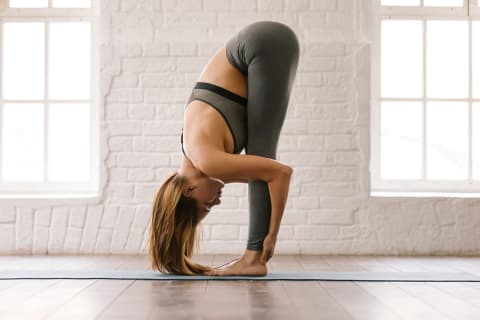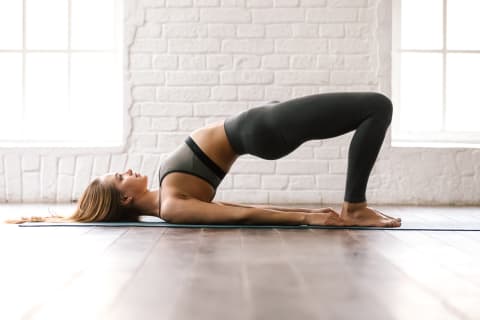Advertisement
Yoga For Migraines: 8 Poses That Can Help Relieve Your Pain


If you’re someone who suffers from debilitating migraines, you know the struggle of trying to find something, anything to relieve the pain. Here are eight poses that can help you relieve those migraines, plus why they’re so beneficial. While everyone is different (and you should always see a doctor if your migraines are affecting your quality of life), rolling out your yoga mat could be a good place to start.
Child’s pose

How to:
- Bring your big toes to touch and walk your knees out wide to the width of your mat.
- Then release your torso onto the ground between your thighs as you walk your fingertips towards the front of your mat.
- Let your forehead rest gently on the floor and rock your head from side to side to massage out the tension.
Why it helps:
Child’s pose is a great way to release tension from your upper body and open up your shoulders, back, and spine, which can increase blood flow to your head. Plus, by resting your forehead on the ground, you’re activating pressure points in your forehead that can relieve migraines and headaches.
Cat and cow pose


How to:
- Start in a neutral tabletop position with your shoulders stacked directly over your wrists and your hips over your knees.
- On your inhale, drop your belly down towards your mat and gaze up towards the ceiling.
- Then, as you exhale, arch through your spine and tuck your chin towards your thighs.
Why it helps:
Moving between cat and cow pose not only relieves tension in your upper body but it also boosts your blood flow and circulation, according to Kelly Smith, E-RYT 500, founder of Yoga for You. This brings more oxygen to your brain, which can help ease some of your headache pain.
Seated forward fold

How to:
- Come onto your sit bones and extend your legs straight out in front of you.
- Inhale to stretch your arms high overhead, then fold forward from your hips, reaching for your shins or your feet.
- Keep the length in your spine as you fold and draw your forehead towards your toes—you can always keep a slight bend in your knees to make this more accessible.
Why it helps:
This pose stretches out your spine and opens up your shoulders, both of which relieve some of the tension often associated with headaches. Also, a seated forward folds in particular help your upper body and neck fully relax, so your head can rest on your legs with no effort.
Ragdoll pose

How to:
- With your feet hips-width distance apart, hinge forward from your hips and release the crown of your head down towards your mat.
- Let your head and neck hang heavy and keep your palms down on your mat or reach for opposite elbows.
- If you feel any strain on your lower back or hamstrings, place a slight bend in your knees.
Why it helps:
Another name for ragdoll pose? Forward fold. “By allowing your head to bow towards the earth and letting go of all tension from your neck and spine, the gentle hug from gravity can help with your headache pain, and create space in the spine and neck,” Smith explains.
Downward dog

How to:
- Start in your tabletop position. Tuck your toes under and lift your hips up and back, sinking your heels down towards your mat.
- Hug your biceps in close to your ears and lengthen through the backs of your legs.
- Let your head and neck relax as you release your torso back towards your thighs.
Why it helps:
Because your heart is above your head in this pose, downward dog is a type of inversion. That means that it can reverse your blood flow, causing a rush of freshly oxygenated blood to your brain.
Legs up the wall

How to:
- Lay on your back and extend your legs straight up towards the ceiling (you can do this against a wall, if you’d like!) so that your legs are perpendicular to your torso.
- Flex your toes back towards your face and let your arms fall down by your sides.
Why it helps:
Legs up the wall is an incredibly restorative pose. Just like in downward dog, your blood is now flowing in the opposite direction—towards your brain. And the more blood and oxygen in your brain, the less painful your headache might be.
Bridge pose

How to:
- Lay on your back with the soles of your feet planted on your ground (so your knees are pointing up) and your arms down by your sides.
- On your inhale, lift your hips up towards the ceiling.
- Keep your chin away from your chest and press the back of your head down into your mat.
Why it helps:
One big reason for migraines? Holding tension in your shoulders and neck. Bridge pose relaxes your upper body and can increase blood to your brain as your heart is lifted above your head.
Savasana

How to:
- Lay on your back with your legs out long and your arms down by your side, palms facing up.
- Relax every muscle in your body (including the ones in your face) and close down your eyes.
- Let your breathing deepen. Stay here for at least 2-5 minutes.
Why it helps:
When you’re in savasana, your entire body is completely relaxed, supported by the ground below you. That release can help reduce your migraine, along with the deep breathing that accompanies this pose, which increases oxygen to your brain.
Tips and warnings.
Poses aren’t the only aspect of yoga that can help with migraines—Smith also adds that breathwork can play a major role in reducing pain. Not sure where to start? She recommends alternate nostril breathing, which she says opens and calms the mind as well as alleviates headaches.
“Use your right hand to plug your right nostril, inhale through the left, then plug the left and exhale through the right,” she explains. “Inhale through the right, plug the right nostril and exhale through the left.” She suggests repeating this eight to 10 times for the most benefits.
Smith is a firm believer that yoga can often be beneficial in relieving migraines: “Studies show that practicing yoga and meditation can help to activate the parasympathetic nervous system, and deactivate the amygdala (the pain and anxiety center of the brain) which can help alleviate headaches from tension, and give you some relief from your pain,” she explains.
However, it’s always best to consult with your doctor before, if you’re new to the mat. While these are good recommendations for the average person, some patients with hypertension or glaucoma (for example) might not be able to do some yoga poses.
Always practice mindfully, too. “Be gentle with yourself and listen to your body,” Smith says. “If something doesn't feel right, don't do it.”